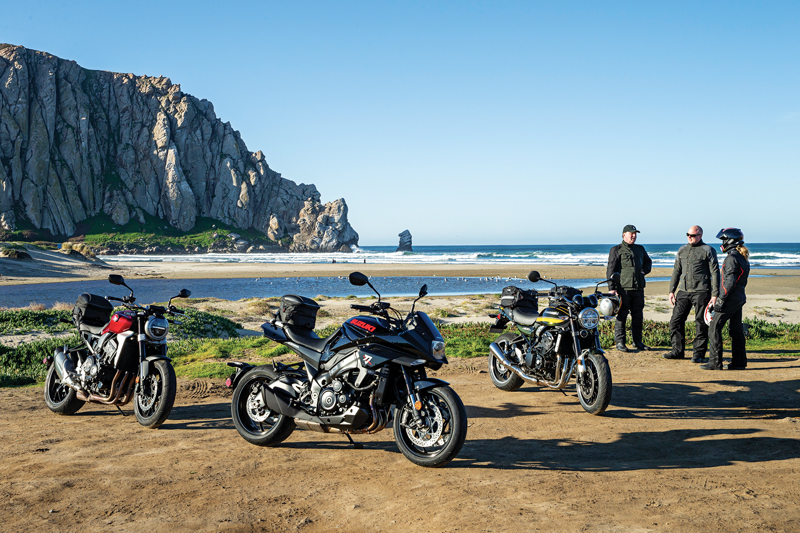
Remember UJMs? If you were a motorcyclist in the ’70s, or have a soft spot for bikes from that era, then you remember them well. Honda kicked it off in 1969 with its groundbreaking CB750, the first mass-produced motorcycle with a transverse in-line four-cylinder engine and an overhead camshaft. It was an air-cooled four-stroke with a five-speed transmission, a front disc brake, an electric starter and an upright seating position.
Honda created the formula and other Japanese manufacturers followed it. Kawasaki launched the mighty 903cc Z1 for 1973, Suzuki introduced the GS750 for 1976 and, late to the party but the biggest reveler in the room, Yamaha brought out the XS1100 for 1978. Similarities among these and other Japanese models of varying displacements led “Cycle” magazine, in its November 1976 test of the Kawasaki KZ650, to coin what became a widely used term: “In the hard world of commerce, achievers get imitated and the imitators get imitated. There is developing, after all, a kind of Universal Japanese Motorcycle…conceived in sameness, executed with precision, and produced by the thousands.”
Those UJMs, and the standards of performance and reliability they established, revolutionized the world of motorcycling. Decades later, descendants of those progenitors carry their DNA into the modern era. To see how well the formula holds up in the 21st century, we gathered examples from Honda, Kawasaki and Suzuki for a neo-retro comparo. (As much as we would have loved to include Yamaha for a proper battle of the Big Four, its contemporary XSR900 is powered by an in-line triple that colors too far outside the lines of the UJM formula.)
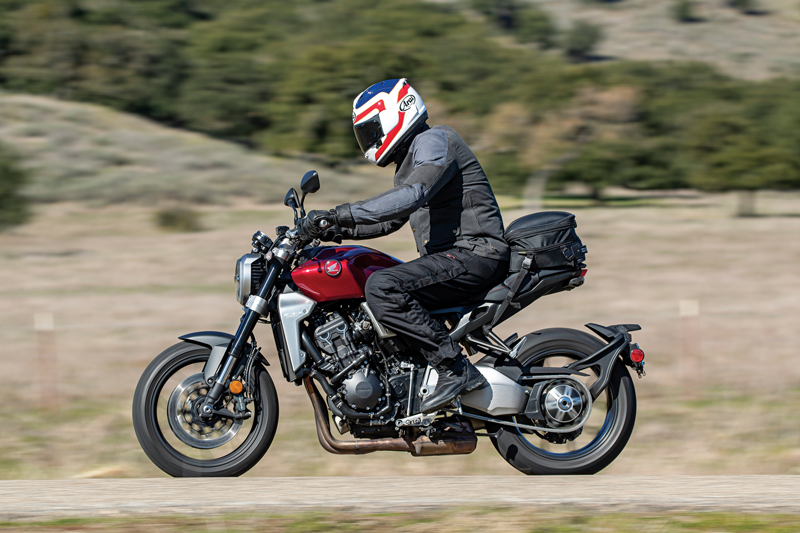
Greg’s Gear
Helmet: Arai Corsair-X
Jacket: Scorpion Birmingham
Pants: Joe Rocket Ballistic
Boots: Sidi Gavia Gore-Tex
Tail Bag: Nelson-Rigg
Honda’s CB1000R, like its granddaddy, has a transverse in-line four, but it’s a more highly evolved one featuring liquid cooling and dual overhead cams with four valves per cylinder — a configuration shared by all three bikes in this comparison. Derived from the pre-2008 CBR1000RR sportbike, the CB’s 998cc engine has been tuned for low- to midrange power and its 6-speed transmission has an assist-and-slipper clutch. Like the others, the CB1000R’s standard equipment includes ABS and traction control, but it’s the only one here with throttle-by-wire and riding modes (Sport, Street, Rain and customizable User), which adjust throttle response, engine braking and traction control.
Read our Road Test Review of the Honda CB1000R here.
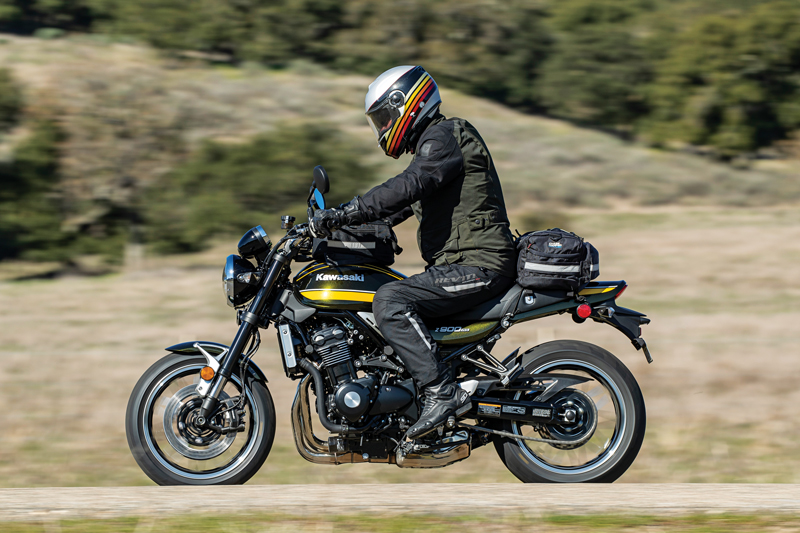
Mark’s Gear
Helmet: Bell SRT Modular
Jacket: Rev’It
Pants: Rev’It
Boots: Sidi Performer Gore-Tex
Tank/Tail Bags: Chase Harper
A round headlight and an exposed engine are about the only styling traits shared by the “Neo-Sports Café” CB1000R and the CB750. Kawasaki’s Z900RS, on the other hand, is a spitting image of its forebear. Round mirrors on long stalks, bullet-shaped analog gauges, a teardrop tank, a bench seat, a sculpted tail and gorgeous Candytone Green paint with yellow stripes are all inspired by the original Z1. Even the flat spokes of its cast wheels are designed to look like spoked wheels of yore. Derived from the Z900 streetfighter, the Kawasaki’s 948cc DOHC in-line four has revised cam profiles, lower compression, a heavier flywheel, a second gear-driven balancer and narrower exhaust headers for a mellower feel, and its stainless steel 4-into-1 exhaust has been tuned to deliver an old-school four-banger growl.
Read our First Ride Review of the Kawasaki Z900RS here.
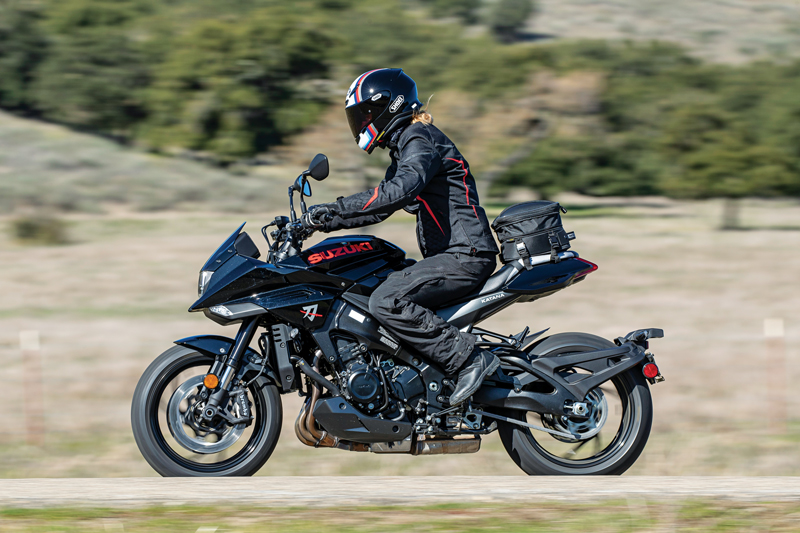
Jenny’s Gear
Helmet: Shoei RF-1200
Jacket: AGV Sport Helen
Pants: Joe Rocket Alter Ego
Boots: Sidi Gavia Gore-Tex
Tail Bag: Nelson-Rigg
Suzuki’s entry in this contest is the new-for-2020 Katana, a modern interpretation of the iconic 1981 GSX1100S Katana, which revolutionized motorcycle design by treating the bike as a whole rather than a collection of parts. Originally conceived by Hans Muth and reimagined by Rodolfo Frascoli, the Katana has a small fairing and windscreen, and, like the CB1000R, a stubby tail section. Based on the GSX-S1000 naked sportbike, the Katana is powered by a 999cc DOHC in-line four derived from the 2005-2008 GSX-R1000, tuned for street duty with milder cam profiles and valve timing, steel rather than titanium valves, lighter pistons, a stainless steel exhaust and a 6-speed transmission with an assist-and-slipper clutch.
Read our First Ride Review of the 2020 Suzuki Katana here.
Three bikes, three editors, two days. Before hitting the road, we strapped on soft luggage. None have centerstands, and only the Kawasaki has a steel gas tank that accommodates a magnetic tank bag, which carried our tools, flat repair kit and air pump. Its long, wide bench seat also has room for a good-sized tail bag. With their short tails and small pillions, the Honda and Suzuki only have space for small tail bags. Because the Suzuki’s bodywork is more stylish than functional, the Honda and Kawasaki are completely nude and none have hand guards or heated grips, we were exposed to the elements. We bundled up in layers for our mid-January test and pointed our wheels north, taking freeways and back roads up California’s Central Coast.
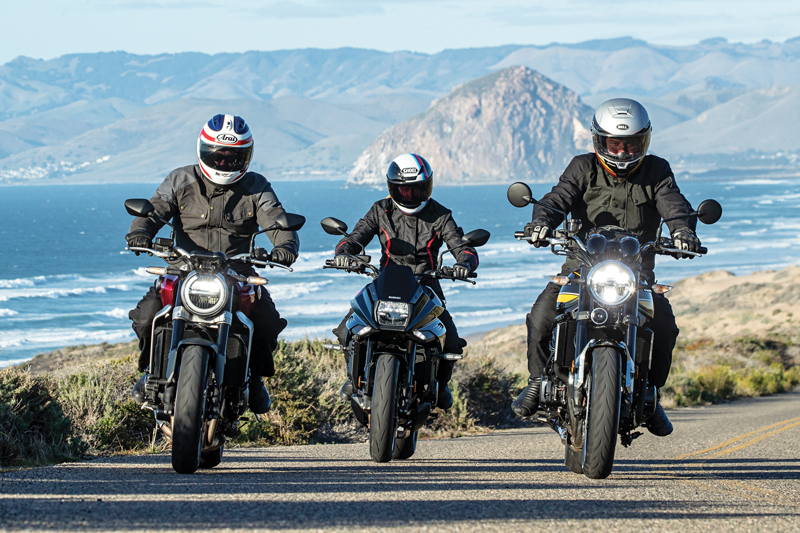
With their refined, Swiss watch-like in-line fours, these modern-day UJMs are impeccably smooth. Snicking their transmissions into sixth gear and cruising at a steady speed is a sublime experience, with minimal vibration or unwanted perturbations. None have cruise control, but with fuel capacities ranging from 3.2 gallons on the Suzuki to 4.5 gallons on the Kawasaki and as-tested fuel ranges between 130 and 173 miles, the need for gas will likely precede the need for wrist relief. Upright seating positions and windblast on the chest keep weight off the wrists on all three, but there are notable differences in legroom. The Honda and Suzuki have the tallest seat heights (32.7 and 32.5 inches, respectively) as well as the highest footpegs, putting much more bend in the knees — especially on the Honda — than the comparatively spacious Kawasaki. Even though the Kawi has the lowest seat height (31.5 inches) and lowest pegs, on none of these bikes did we find ourselves dragging pegs in tight corners.
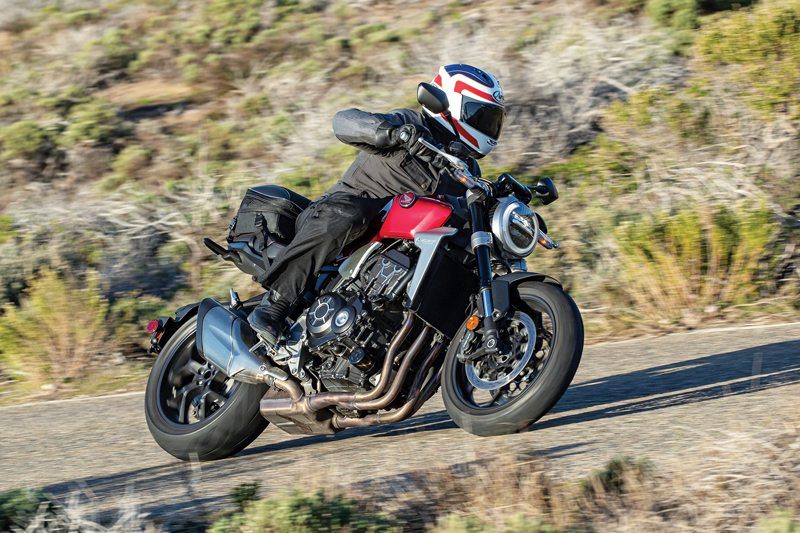
It’s in those tight corners that these bikes further distinguish themselves. With only 10 pounds separating their curb weights and modest differences in chassis geometry, their engine performance, brakes and suspension are what set these bikes apart. In terms of outright horsepower and torque, the Honda and Suzuki, both of which have sportbike-derived engines, come out on top. The Suzuki is the strongest, churning out 142.1 rear-wheel horsepower at 10,300 rpm and 75.9 lb-ft of torque at 9,200 rpm on Jett Tuning’s dyno, though its advantage over the others is mostly above 8,500 rpm. The Honda peaks at 125.5 horsepower at 9,800 rpm and 70.6 lb-ft at 8,300 rpm, but it’s much weaker than the Suzuki and Kawasaki below 7,500 rpm, a deficiency that’s obvious on corner exits and roll-on passes. Although the Kawasaki generates only 100.1 horsepower at 8,500 rpm and 67.5 lb-ft at 8,500 rpm, in the midrange it gives the Suzuki a run for its money and leaves the Honda in the dust.
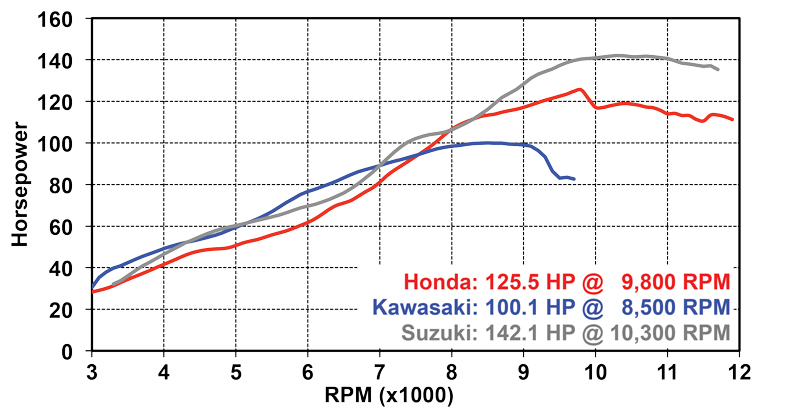
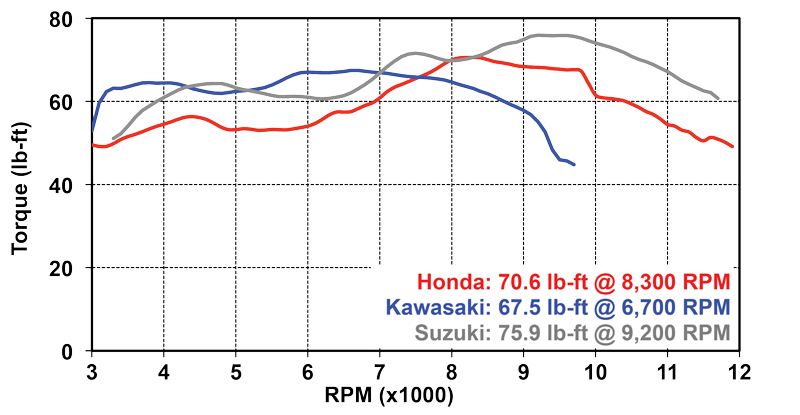
With their more compact cockpits and high-revving power, the Honda and Suzuki lean more toward the sport end of the sport standard spectrum. Their smoothness makes them sneaky fast, and their stock suspension settings are firmer than the Kawasaki’s. All of these bikes have fully adjustable upside-down forks and preload- and rebound-adjustable single rear shocks (KYB on the Kawasaki and Suzuki, Showa on the Honda), but the Honda’s suspension, especially its Separate Function-Big Piston fork, is the most compliant. Sportbike-caliber front brakes, with pairs of radial-mount monoblock 4-piston opposed calipers clamping large discs, deliver serious stopping power across the board, but the Honda has a slight edge in feel. Adding to a sense of confidence on the Honda are its Bridgestone Battlax Hypersport S21 radials, which have noticeably more grip (but likely less mileage in the long run) than the Dunlop radials on the Kawasaki and Suzuki.
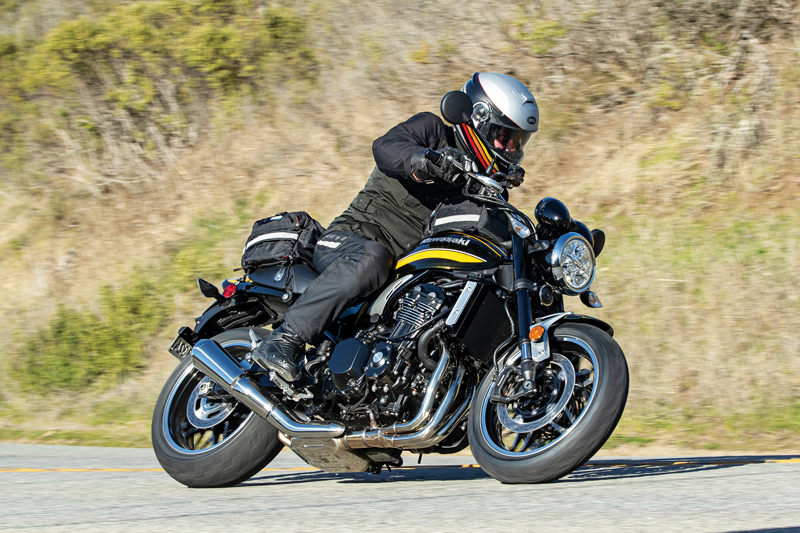
Despite being down on peak power and more softly sprung, the Kawasaki is by no means a boat anchor or a couch on wheels. It’s plenty fast, but its mission is clearly different than that of the Honda and Suzuki. The Z900RS stokes the flames of nostalgia while providing a more spacious, relaxed and comfortable riding experience, with every potentially rough edge sanded smooth. The Katana, on the other hand, is essentially a GSX-S1000 with plastic bodywork and a more upright riding position. In isolation there’s little to complain about when riding the Suzuki, but compared to the Honda and Kawasaki, it feels less refined, with more driveline lash and less precision during gear changes.
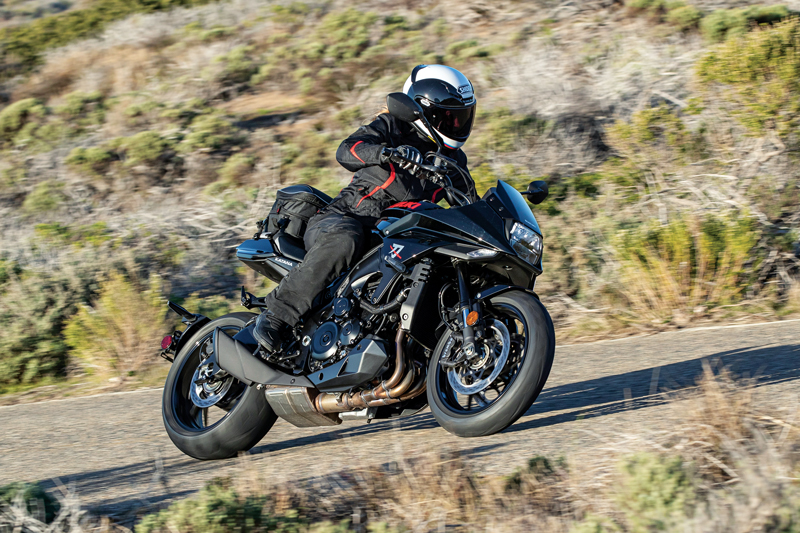
UJMs were the first motorcycles to be called “superbikes,” a name that came to be more appropriately applied to the racer replicas that proliferated in the late ’80s. These modern-day UJMs fall into the more mundane-sounding “sport standard” category, but there’s nothing mundane about 100-plus rear-wheel horsepower, high-spec brakes and suspension, standard ABS and TC, and a level of capability that’s truly impressive. For sheer power and sporting prowess, the Suzuki gets top marks, but its small 3.2-gallon gas tank and high price ($13,499) make it a tough sell. Priced a bit lower at $12,999, the ultra-smooth Honda has a strong top end as well as throttle-by-wire, riding modes and the best suspension and tires, but its weak midrange and high footpegs limit its overall appeal. A relative bargain at $11,199, the Kawasaki won us over with its throwback styling, spacious and comfortable seating, strong midrange, seductive sound and decent fuel range. If you do what we did — strap on some luggage and explore some of your favorite roads for a couple of days — you’re guaranteed to have a good time. Isn’t that why we ride?
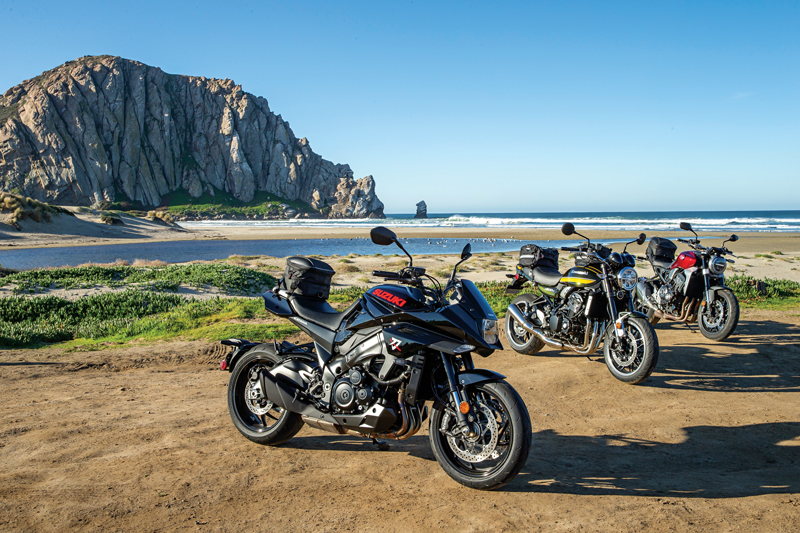
Keep scrolling past spec charts for more photos….
2019 Honda CB1000R ABS Specs
Base Price: $12,999
Warranty: 1 yr., unltd. miles
Website: powersports.honda.com
Engine
Type: Liquid-cooled, transverse in-line four
Displacement: 998cc
Bore x Stroke: 75.0 x 56.5mm
Compression Ratio: 11.6:1
Valve Train: DOHC w/ 4 valves per cyl.
Valve Insp. Interval: 16,000 miles
Fuel Delivery: PGM-FI w/ throttle-by-wire & 44mm throttle bodies x 4
Lubrication System: Wet sump, 3.2-qt. cap.
Transmission: 6-speed, hydraulically actuated wet assist-and-slipper clutch
Final Drive: O-ring chain
Electrical
Ignition: Fully transistorized
Charging Output: 350 watts max.
Battery: 12V 8.6AH
Chassis
Frame: Mono-backbone steel frame, single-sided cast aluminum swingarm
Wheelbase: 57.3 in.
Rake/Trail: 24.7 degrees/3.8 in.
Seat Height: 32.7 in.
Suspension, Front: 43mm USD fork, fully adj., 4.3-in. travel
Rear: Single shock, adj. for spring preload & rebound damping, 5.2-in. travel
Brakes, Front: Dual 310mm floating discs w/ 4-piston monoblock radial opposed calipers & ABS
Rear: Single 256mm disc w/ 2-piston pin-slide caliper & ABS
Wheels, Front: Cast, 3.5 x 17 in.
Rear: Cast, 6.0 x 17 in.
Tires, Front: 120/70-ZR17
Rear: 190/55-ZR17
Wet Weight: 463 lbs.
Load Capacity: 390 lbs.
GVWR: 853 lbs.
Performance
Fuel Capacity: 4.3 gals., last 1.0 gal. warning light on
MPG: 91 AKI min. (low/avg/high) 30.7/35.8/39.9
Estimated Range: 154 miles
Indicated RPM at 60 MPH: 4,250
2020 Kawasaki Z900RS ABS Specs
Base Price: $11,199
Warranty: 1 yr., unltd. miles
Website: kawasaki.com
Engine
Engine Type: Liquid-cooled, transverse in-line four
Displacement: 948cc
Bore x Stroke: 73.4 x 56.0mm
Compression Ratio: 10.8:1
Valve Train: DOHC, 4 valves per cyl.
Valve Insp. Interval: 15,000 miles
Fuel Delivery: DFI w/ 36mm throttle bodies x 4
Lubrication System: Wet sump, 4.2-qt. cap.
Transmission: 6-speed, wet assist-and-slipper clutch
Final Drive: O-ring chain
Electrical
Ignition: TCBI w/ digital advance
Charging Output: 336 watts max.
Battery: 12V 8AH
Chassis
Frame: High-tensile steel trellis w/engine as stressed member, cast aluminum swingarm
Wheelbase: 58.1 in.
Rake/Trail: 25.4 degrees/3.5 in.
Seat Height: 31.5 in.
Suspension, Front: 41mm USD fork, fully adj., 4.7-in. travel
Rear: Single shock, adj. for spring preload & rebound damping, 5.5-in. travel
Brakes, Front: Dual 300mm discs w/ opposed 4-piston monoblock calipers & ABS
Rear: Single 250mm disc w/ 1-piston caliper & ABS
Wheels, Front: Cast, 3.50 x 17 in.
Rear: Cast, 5.50 x 17 in.
Tires, Front: 120/70-ZR17
Rear: 180/55-ZR17
Wet Weight: 472 lbs.
Load Capacity: 398 lbs.
GVWR: 870 lbs.
Performance
Fuel Capacity: 4.5 gals., last 1.0 gal. warning light on
MPG: 90 AKI min. (low/avg/high) 34.5/38.5/45.4
Estimated Range: 173 miles
Indicated RPM at 60 MPH: 3,750
2020 Suzuki Katana Specs
Base Price: $13,499
Warranty: 1 yr., unltd. miles
Website: suzukicycles.com
Engine
Type: Liquid-cooled, transverse in-line four
Displacement: 999cc
Bore x Stroke: 73.4 x 59.0mm
Compression Ratio: 12.2:1
Valve Train: DOHC w/ 4 valves per cyl.
Valve Insp. Interval: 15,000 miles
Fuel Delivery: EFI w/ SDTV & 44mm throttle bodies x 4
Lubrication System: Wet sump, 3.4-qt. cap.
Transmission: 6-speed, cable-actuated assist-and-slipper clutch
Final Drive: O-ring chain
Electrical
Ignition: Transistorized, digital electronic
Charging Output: 385 watts max.
Battery: 12V 8.6AH
Chassis
Frame: Cast aluminum twin-spar w/ cast aluminum swingarm
Wheelbase: 57.5 in.
Rake/Trail: 25 degrees/3.9 in.
Seat Height: 32.5 in.
Suspension, Front: 43mm USD fork, fully adj., 4.7-in. travel
Rear: Single link-type shock, adj. for spring preload & rebound, 5.1-in. travel
Brakes, Front: Dual 310mm discs w/ radial-mount monoblock 4-piston opposed calipers & ABS
Rear: Single 220mm disc w/ 1-piston pin-slide caliper & ABS
Wheels, Front: Cast, 3.50 x 17 in.
Rear: Cast, 6.00 x 17 in.
Tires, Front: 120/70-ZR17
Rear: 190/50-ZR17
Wet Weight: 473 lbs.
Load Capacity: 407 lbs.
GVWR: 880 lbs.
Performance
Fuel Capacity: 3.2 gals., last 1.0 gal. warning light on
MPG: 90 AKI min. (low/avg/high) 36.2/40.6/46.5
Estimated Range: 130 miles
Indicated RPM at 60 MPH: 4,000
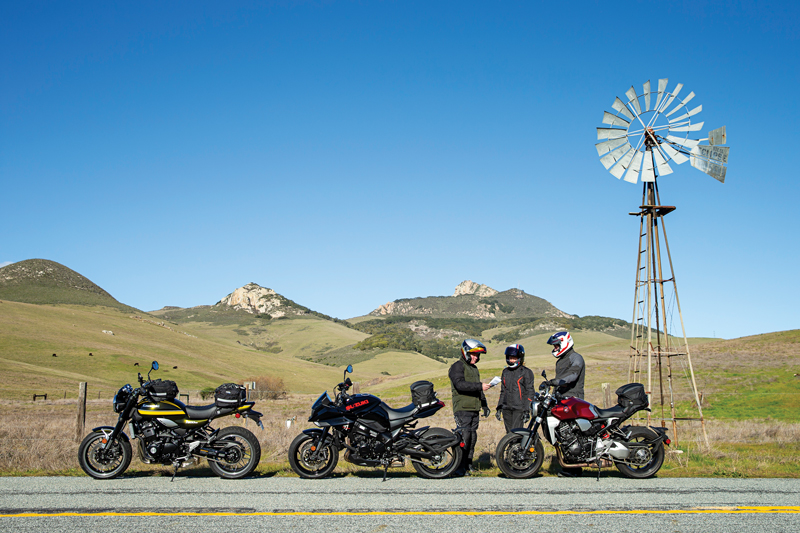
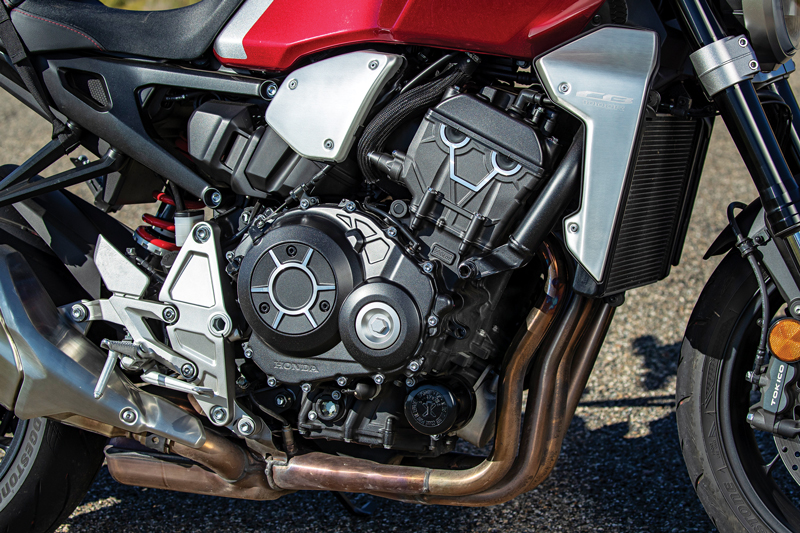
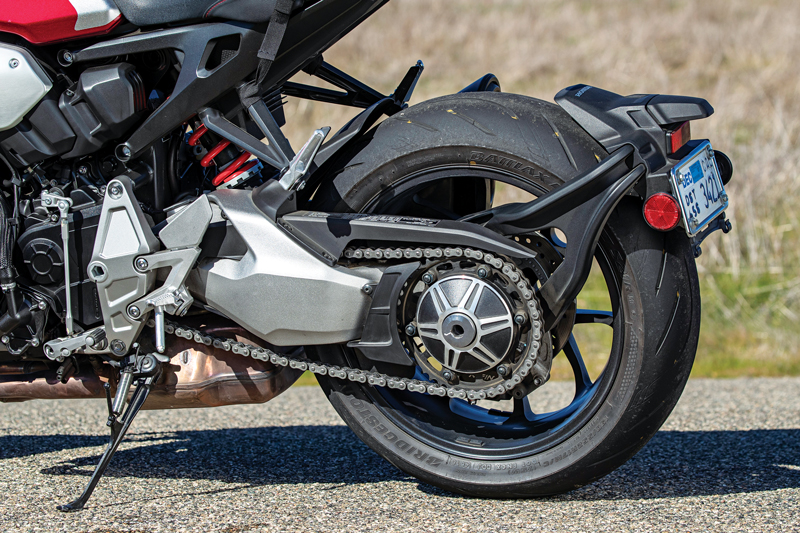
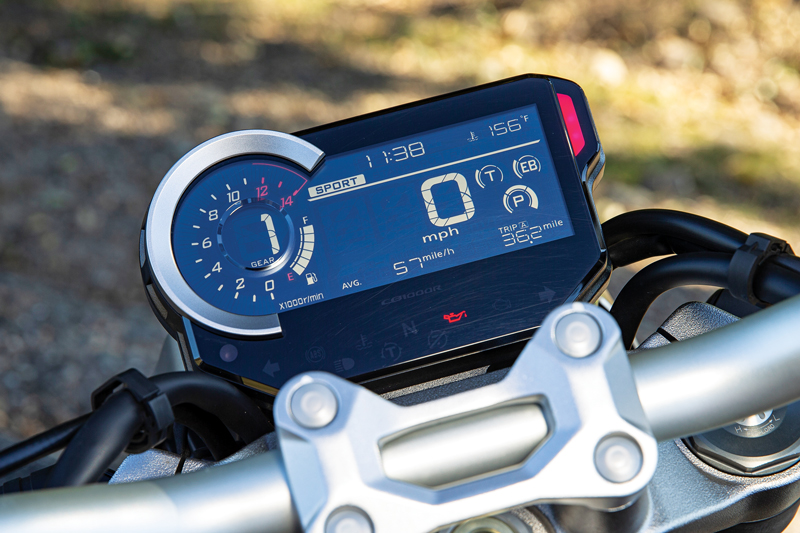
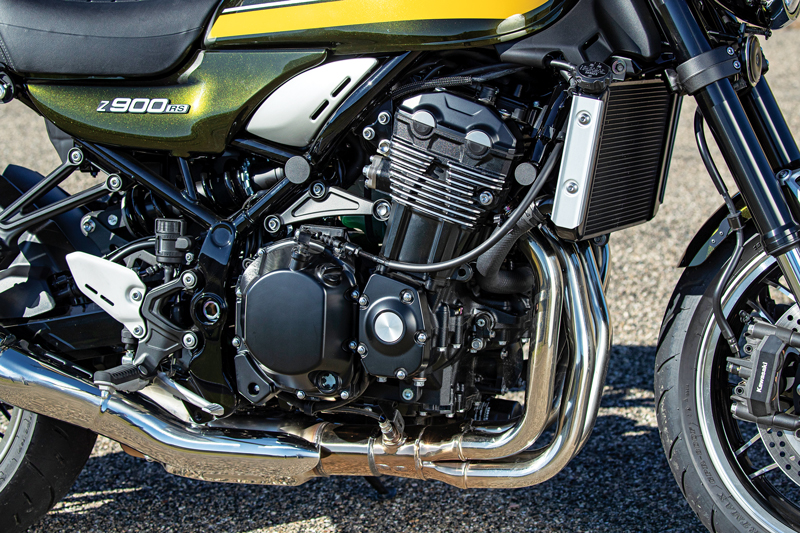
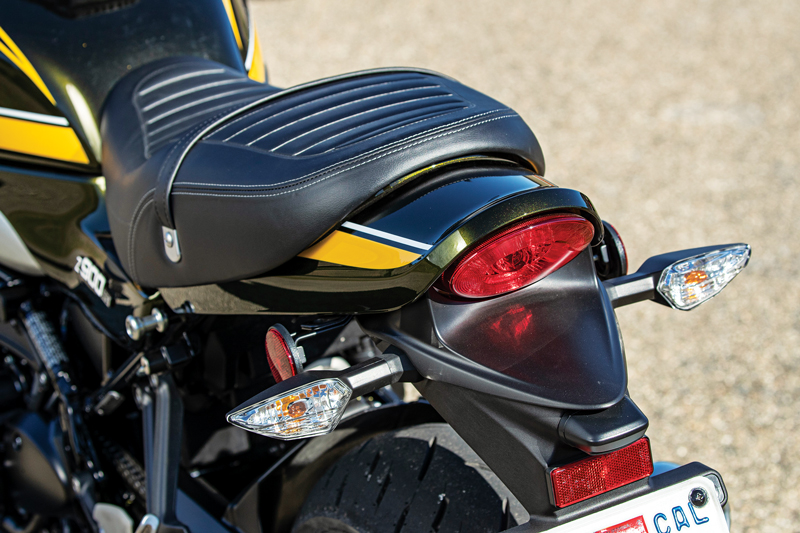
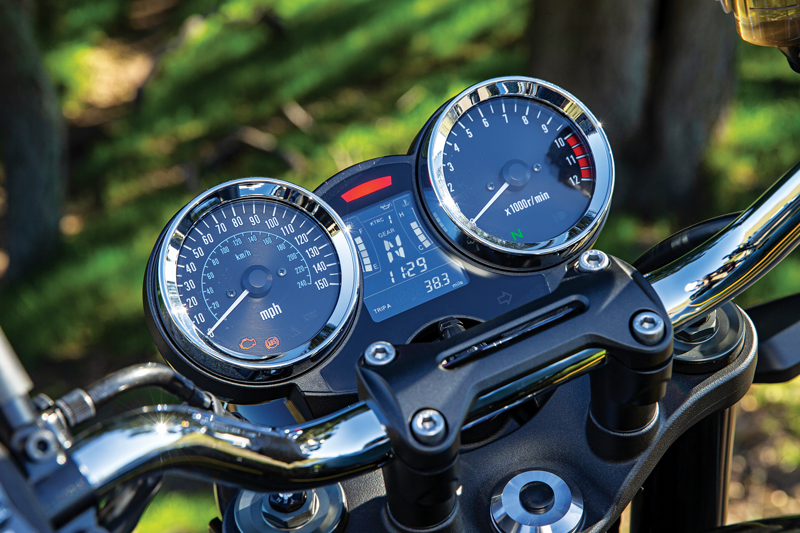
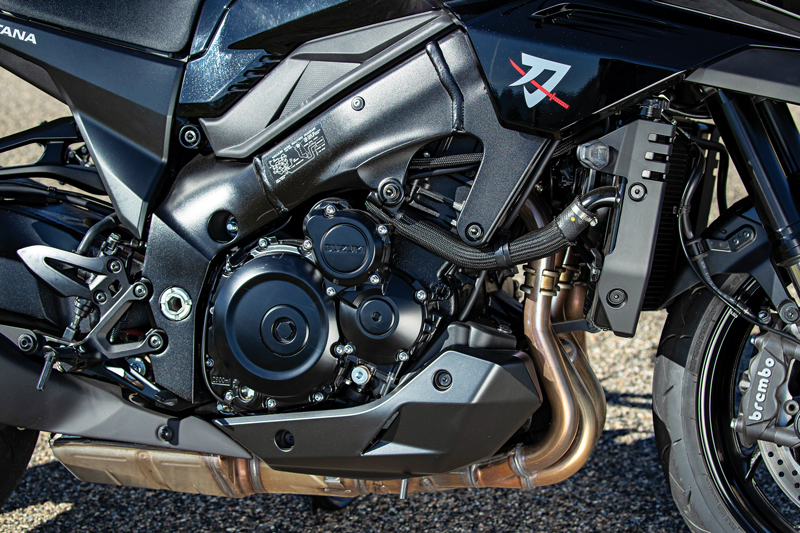
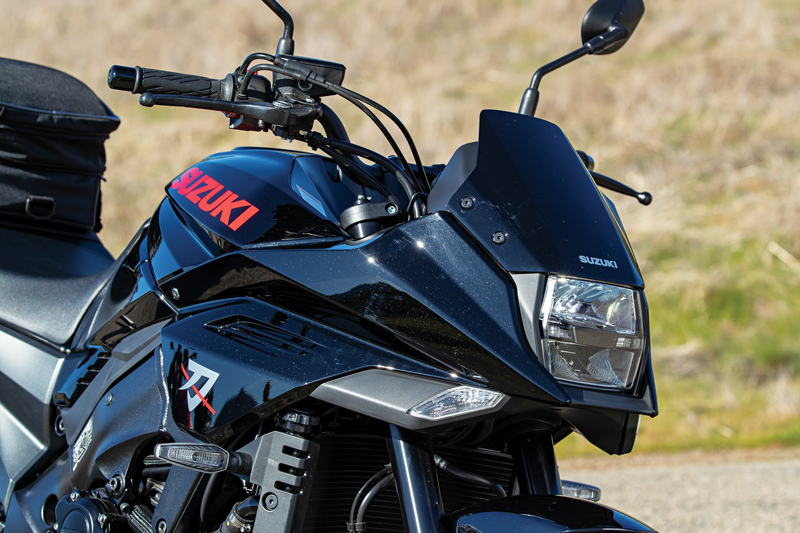
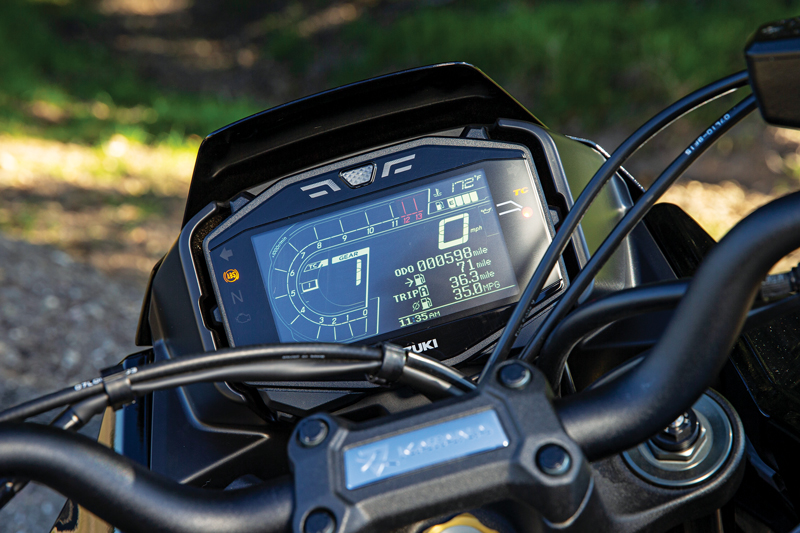

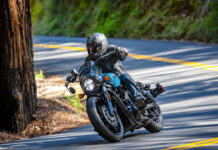






It sure would be nice if you could do a bit more homework before publishing this, the original Katana was a 1982 model and it was a 1000 cc engine, not a 1100cc. I will date myself, I was there and almost bought one.
Perhaps it is you who should do the homework. The first Katana was a 1981 model and had a 1,100cc engine. It was not sold in the U.S., however, which is why you are confused. The following year, in 1982, it was brought here but in a smaller 998cc version (for racing homologation reasons I believe).
Awesome Jenny. It’s always nice when you can prove a pendantic dickwad is in fact a pendactic dickwad. 😀
I’m leaning towards the CB1000R but right now I’m very happy with my Yamaha XSR900.
The 1st Katana available was released in Europe as a 1100cc. I was one of the first in the UK to buy one. It went well but it weaved in a long fast corner, not dangerous but challenging on the limit.
Hi . True 1st ones were 1000”s with flats slide carbs etc ltd no”s for production racing homlagation, 2nd 1100s cane outmany more made. I
Almost got one too😳. Much more modern then Gs 1000”s . Gsxs r slabbys were 1st bikes to Bea’s much fun as lc”s though 😍👍🏃😎
Would have been nice to see the Triumph Speed Twin in the mix. It looks more like my 1969 CB350, or a CB750, than any of the three tested here; and its performance might be not far off from this group of bikes but has very good looks. 96HP/83ft-lbs/435 lbs. dry. Weren’t the UJMs patterned after Triumphs back in the day? These three don’t appear to be, hardly retro from that perspective.
Common on the web, some people, even after being repeatedly told, just do not quite get the UJM criteria. You are confusing UJM with “standard” and Japanese with British and Twin with Four. In summary, lotta confusion.
Any of these bikes would make that look like what it is – a cruiser with a tad less lard. These machines have modern performance with styling references to the past. Good enough.
Maybe also throw in a reliability test as well between the RS and Bonnie, who could possibly win?
Way to neuter that midrange, Honda!
You Go Kawasaki😀😀😀… sounds like the winner for me……More comfortable, lower seat height, lower pegs😀great midrange power, great growl sound..least expensive…..thank you Rider and staff for this great comparison article…well done, Rod Welles
It also nailed the look.
Can I give this magazine a: Thank you, well done to all involved in its production, and please keep up the good work and interest content. I speak both personally and on behalf of the UK riding community.
Dave. The early non-Honda Japanese twins of the ’60s were patterned on BSA twins. A7 500 and A10 650cc.
The Kawasaki really cloned the A7 for their Twin back then and it’s Retro descendants are the W650 and W800’s.
Currently own a 2018 Kawasaki Z900Rs. Great bike with about 10,000 miles and no problems starting each morning. Commute every day on it. I don’t need to race; just need enough power to get away from inattentive drivers on the road.
You could do that with half the hp – c’mon fess up – twisting out 100hp is a f*ck load of fun. We won’t tell.
I am also looking at the RS as well. I wonder if they fixed the throttle hi jinks from earlier models?
“Three bikes, three editors, two days.”
Publications, print and web, seem to only have a bunch of “editors” these days. When I was a young journo, we were called “writers”. Editors were our bosses who assigned, evaluated, and sometimes tweaked our written work. They were senior to us, and more experienced, which is why they actually “edited” things. A similar phenomenon exists in movies and television. During opening credits count the number of executive producers listed-you usually need fingers from at least two hands.
Right on Tom Reece. Nowadays, everyone seems to be afflicted with great self importance, and as a result, most organizations (including businesses), have too many chiefs and not nearly enough indians (no PC in me). If the staff of this outfit are all “editors”, who is writing the stories?
Which model saddle bag and tank bag on the Kawasaki? I am interested in getting those
The Honda has 143.5 bhp. The old blade engine has been refined and up rated from the 2008 to 2017 CB1000R. It has larger throttle bodies and forged as opposed to cast pistons and higher valve lift. It is typical superb Honda engineering.. A pussy at in town tooting around in top gear or a snarling rev monkey out on the open road in full fat sport mode.
But a point is being missed here the kawa and the suzi are both fine bikes, but they are full retro. In the case of the KawaRS just a straight copy. The CB isn’t. It is new, modern and innovative. It has naked cafe references, but also moves things on. I think it is superb and may well go down in a long line of Honda classics such as the original CB750, the CBR600F, the Blackbird, the Cub, the Fireblade. These have all been game changers. Well done Honda I reckon
I just bought a 2019 Honda CB1000R, moving up from a 2019 CBR650R. I did a lot of research, watching YouTube video and reading sites like these. So far i like it but definitely need to invest in a front fairing because im getting slammed with alot of wind!. I saw PUIG makes a nice one. Anyone have any suggestions of other manufacturers?
Thanks for the article!
Cycle World dyno with the new CB producing 121.8 peak horsepower at 9,800 rpm. The Honda is really down on power compared to the Suzuki.
The 2021 CB1000R HAS FORGED PISTONS AND CRANKS OUT 143 HORSEPOWER.
Hey guys I just bought a 2019 version of this Honda in red and wow she is good looking!!! I have several other bikes but I cannot wait for the weather to allow me to try her. I have an MT10SP which goes like a bat out of hell plus an FJR1300 for longer trip but this Honda look stunning…..
I think the 2021 CB 1000R black edition will go down as a cult classic as time goes on! It is unfortunate that Honda saw fit to not put cruise control on the bike when so many others in the naked bike class have it. I hope Honda will put it on the US models. If not Honda if you’re listening please offer a OEM kit since it will likely be plug and play since it’s drive by wire anyway. At any rate I can’t wait to see the bike in person and will likely buy one! To My eye it’s one of the best looking bikes in years
Doing some research on the Z900RS it seems not any difference between the 2022 & 2023. I do like the Rootbeer color RS, reminds me of my first bike the KH400.